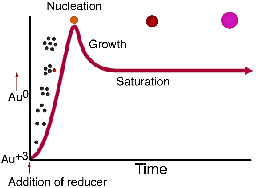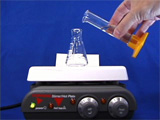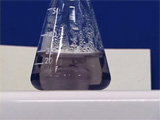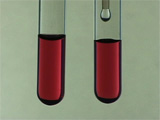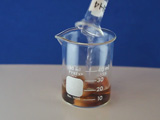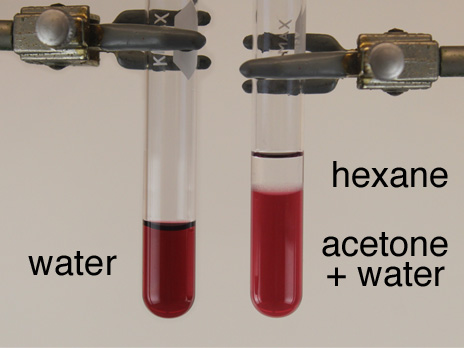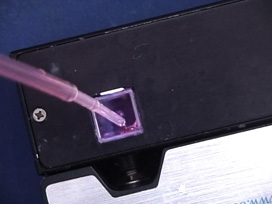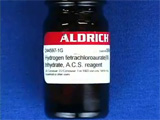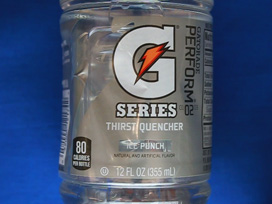
Synthesis of Gold Nanoparticles
The citrate synthesis procedure is from A. D. McFarland, C. L. Haynes, C. A. Mirkin, R. P. Van Duyne and H. A. Godwin, "Color My Nanoworld," J. Chem. Educ. (2004) 81, 544A. The borohydride synthesis procedure and extraction test was modified by E. Koenig and G. Lisensky from M. N. Martin, J. I. Basham, P. Chando, and S. Eah, "Charged Gold Nanoparticles in Non-Polar Solvents," Langmuir (2010) 26(10), 7410-7417. The laser pointer activity was added by G. Lisensky. The electrolyte analysis of sports drinks was developed by Andrew Greenburg.
Before the addition of the reducing agent, the gold is in solution in the Au+3 form. When the reducing agent is added, gold atoms are formed in the solution, and their concentration rises rapidly until nucleation begins. The remaining dissolved gold atoms bind to the nucleation sites and growth occurs with the solution concentration of gold atoms at saturation. See "Producing gold colloids" (pdf) from IVD Technology.
Au+3 ions can be reduced to neutral gold atoms by more than one method.
- Citrate ions act as a weak reducing agent and a capping agent.
 The Au+ then disproportionates (reacts with itself) in water to produce Au0,
The Au+ then disproportionates (reacts with itself) in water to produce Au0,
3AuCl2- → 2Au0 + AuCl4- + 2Cl-. - Borohydride acts as a strong reducing agent.
The formation of gold nanoparticles can be observed by a change in color since small nanoparticles of gold are red. The presence of this colloidal suspension can be detected by plasmon emission when the particles are excited by a laser beam. The peak width of the plasmon emission is a measure of the size distribution of the particles. Switching to a smaller anion for the capping agent allows the particles to approach more closely and a color change is observed.
| Procedure | Wear eye protection |
Chemical gloves recommended |
 Never look directly into a laser
or shine a laser at another person. Never look directly into a laser
or shine a laser at another person. |
Citrate Synthesis Method
Rinse all glassware with pure water before starting. Add 20 mL of 1.0 mM HAuCl4 to a 50 mL beaker or Erlenmeyer flask on a stirring hot plate. Add a magnetic stir bar, bring the solution to a rolling boil, and move on to the next step. To the rapidly-stirred boiling solution, quickly add 2 mL of a 1% solution of trisodium citrate dihydrate, Na3C6H5O7.2H2O. The gold sol gradually forms as the citrate reduces the gold(III). Remove from heat when the solution has turned deep red or 10 minutes has elapsed. (Gaps in the movie indicate equal gaps in time. The total elapsed time is approximately 10 times the movie length.) Special spacer-change test for this method: Put a small amount of the gold nanoparticle solution in each of two test tubes. Use one tube as a color reference and add 5-10 drops of NaCl solution to the other tube, recording the color after each drop. Does the color of the solution change as the addition of chloride makes the nanoparticles closer together? Option: this part could be done in a cuvet with the visible spectrum recorded after each drop. Borohydride Synthesis Method (Prepare for both steps before starting.)
Rinse all glassware with pure water before starting. Add 10 mL of 1.0 mM HAuCl4 to a 50 mL beaker or Erlenmeyer flask on a stirring plate. Add a magnetic stir bar and begin stirring but do not heat. When you are ready to proceed with the size test, quickly add 10 mL of 3.0 mM NaBH4 and mix. Proceed with the size test immediately, and time how quickly you can go from the addition of the NaBH4 through to the addition of the alkanethiol in the next step. Special size test for this method: Add about a cm of product solution to a screw cap vial or test tube. Add about a 0.5 cm of acetone, cap and shake for 1 s, then add about a 0.5 cm of 0.2 mM dodecanethiol in hexane. Cap and shake to mix. Gold particles smaller than 5 nm will transfer to the top layer. What happens for your products? Are your nanoparticles smaller or larger than 5 nm? Discard the hexane, alkanethiol, and acetone in an organic waste bottle. (Only the water solution from the synthesis step can be used to record the visible spectrum below since this organic solution will dissolve the cuvet.) Tests for both methods
Record the visible spectrum of the product solutions. If necessary, add additional water to the cuvette to get the absorbance on scale. What is the peak wavelength? What is the peak width at half height? The light from a laser pointer may be polarized with the electric field oscillation in only in one plane. Test your laser pointer with a polarizing filter to see if the laser emits polarized light. Return the polarizing filter and now use a gold nanoparticle solution instead of the filter. Shine the laser through the solution and rotate the laser. What fraction of a full rotation separates the maximum and minimum observed brightness? Conclusions
- What color is the product from each method?
- What color is the product when the spacer is changed from citrate to chloride?
- Summarize your evidence that light from the laser pointer is polarized.
- What is the wavelength of the visible absorption peak maximum for each of the metal nanoparticle syntheses? What is the peak width at half the maximum height (fwhm) of the visible absorption? For the latter you may need to measure the width of the longer wavelength half and then double it to get the full width.
- In Anal. Chem. 2007, 79, 4215-4221 it is reported that for gold nanoparticles with a diameter greater than 30 nm, the diameter equals
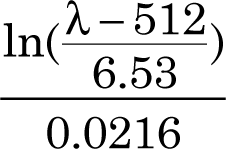 where λ is the absorption peak wavelength. What is the calculated diameter for your nanoparticles?
where λ is the absorption peak wavelength. What is the calculated diameter for your nanoparticles? - How long did it take between the addition of the NaBH4 to the addition of the alkanethiol? What were your observations? Were the particles smaller than 5 nm (interpret your observations)?
- Which method gives smaller nanoparticles? How do you know?
Stock Solutions for 25 batches
- 1.0 mM hydrogen tetrachloroaurate: The solid is hygroscopic so purchase HAuCl4.3H2O (Aldrich 244597 or 520918) in 1.0 g quantities and use the entire bottle. Dissolve 1.0 g HAuCl4.3H2O in 250 mL distilled water to make a 10.0 mM stock solution of gold(III) ions that can be kept for years if stored in a brown bottle. Dilute 25 mL of stock to 250 mL to make the 1.0 mM concentration for this experiment.
- 1% trisodium citrate: Dissolve 0.5 g Na3C6H5O7.2H2O (sodium citrate) in 50 mL distilled water.
- 3.0 mM NaBH4: Dissolve 0.0284 g NaBH4 in 250 mL water. This solution should be made fresh before the experiment. BH4 slowly decomposes in neutral water to produce H2 gas. Solutions should not be kept overnight or tightly sealed.
- 0.2 mM dodecanethiol in hexane: 1.2 uL dodecanethiol in 25 mL hexane with glass pipet for dispensing.
- Acetone
- NaCl solution: Dissolve at least 0.5 g of NaCl in 10 mL distilled water or use a saturated solution.
- Optional sports drinks: Gatorade Ice, Powerade, Flavorless Pedialyte, Pickle Juice. Colorless or as little color as possible solutions work better. You can test electrolyte content in sports drinks by counting drops needed to change the color of 7 drops of gold nanoparticle solution.
Equipment
- 50 mL Erlenmeyer flask or beaker (a beaker works better for the laser tests)
- Graduated cylinders: 25 mL (HAuCl4), 10 mL (Na3Citrate) and 10 mL (NaBH4)
- 1" or 1 cm stir bar. After the experiment clean stir bars with aqua regia (3:1 HCl:HNO3 with eye protection, chemical gloves, and a fume hood.)
- Stirring hotplate (Corning digital setting about 220.)
- Laser pointer, polarizing filter
- Dropper bottles and test tubes or cuvets for NaCl tests
University of Wisconsin Materials Research Science and Engineering Center
Interdisciplinary Education Group | MRSEC on Nanostructured Interfaces
This page created by George Lisensky, Beloit College. Last modified September 23, 2018 .
